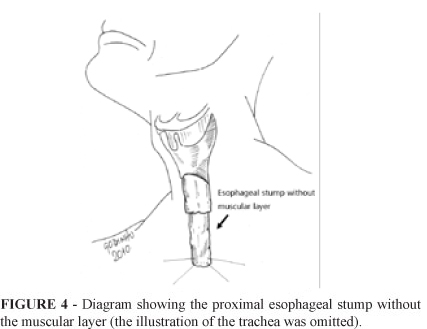PURPOSE: To evaluate the incidence of fistula and stenosis of the cervical esophagogastric anastomosis with invagination of the proximal esophageal stump into the stomach after subtotal esophagectomy. METHODS: We studied 54 patients who underwent subtotal esophagectomy, 45 (83.3%) patients with carcinoma and nine (16.6%) with advanced megaesophagus. In all cases the cervical esophagogastric anastomosis was performed with the invagination of the proximal esophageal stump inside the stomach. RESULTS: Three (5.5%) patients had a fistula at the esophagogastric anastomosis, two of whom with minimal leakage of air or saliva and with mild clinical repercussion; the third had a low output fistula that drained into the pleural space, and this patient developed empyema that showed good progress with drainage. Fibrotic stenosis of anastomosis occurred in thirteen (24%) subjects and was treated successfully with endoscopic dilatation. CONCLUSION: Cervical esophagogastric anastomosis with invagination of the proximal esophageal stump into the stomach tube presented a low rate of esophagogastric fistula and stenosis, thus becoming an attractive option for the reconstruction of alimentary transit after subtotal esophagectomy.
Esophagus; Esophagectomy; Constriction, Pathologic; Anastomotic Leak, Gastroplasty




